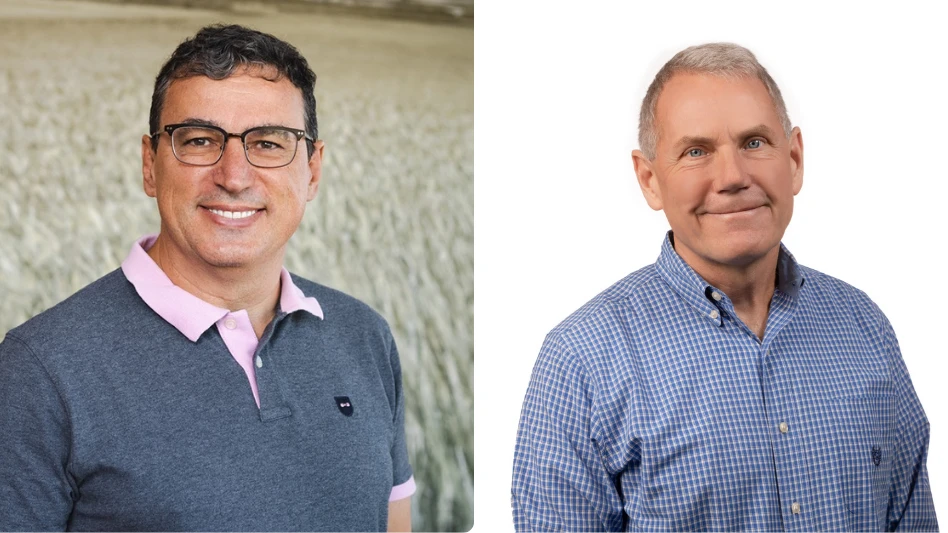Everyone knows that adding organic matter to soils can be beneficial to the plants growing in those soils – especially if the organic matter is compost. Just talk to any of your grandparents about how they successfully raised gardens years ago and they will tell you compost was the central ingredient to their success.
However, there have always been issues related to simple and effective applications that have kept compost markets from developing and limited compost applications for the landscape industry. For more than 10 years, I have struggled to find an easier way to apply good quality compost to turf, ornamental beds and other applications in the landscape. My efforts have generally resulted in little success.
For those of you who have topdressed turf with screened compost, you know the issues that face our industry – a lot of raking and a lot of manual work, costing everyone a lot of money. For that reason, compost is often left out of landscape installation or maintenance activities today.
Expensive equipment that has evolved over the last 10 years has focused mainly on applying large volumes of a finely screened compost (½-inch or less) and there is still a void in equipment available for smaller commercial applications. (In fact, I surmise that many homeowners who know they should topdress their lawns with compost don’t because they do not have a quick and efficient application method themselves.)
Recently, I learned about the process of pelletization of compost. Although we all know what pelletization does, it seems that there are very few products on the market that represent strictly pelletized compost. For instance, there are fertilizer pellets, bridge products, which are pelletized, and some biosolids, which are also pelletized, that are available. But pure compost seems to be missing in pellet form.
Therefore, the habit of topdressing a lawn using a regular fertilizer spreader during spring or fall after aeration has mostly been limited to commercial projects that are large enough to warrant bringing in at least one full truckload of screened compost, loaders, manure spreaders, etc.
Without the scale of such a project, which is normally several acres, the mobilization costs of machinery eat up whatever potential profit there might have been in the job for the contractor. Without pelletization, application with a conventional broadcast fertilizer spreader is nearly impossible because screened compost bridges and clogs up the impeller.
| BENEFITS OF |
|
PELLETIZED COMPOST
The following list explains some of the benefits of pelletized composts: LESS WASTE – Pelletization offers a clean product without a lot of dust. Applying screened compost is a messy job and there always seems to be some high and low spots in the lawn or landscape bed when you are finished. Pellets allow for a more uniform and efficient application. ACCURATE APPLICATION – Getting the pellets where you want them is easier because they act more like fertilizer pellets in a spreader. Technicians can also apply pellets by hand and get in and around tight landscape plants with onerous or low branches. This is harder to do with screened compost, which often hangs up on parts of the plant and needs to be watered into them. REDUCE APPLICATION LABOR COSTS – How much labor can be saved remains to be seen, but this would certainly be an advantage of pelletized compost. None of your employees enjoy raking out 10 cubic yards of compost on a lawn. This takes a lot of time and, if you are paying the labor, the cost adds up. By comparison, adding pelletized compost is no more expensive than your spring or fall lime applications that may already be a part of your turf care program. DELIVER ADDITIONAL NUTRITION – In an ideal world where every lawn is aerified and topdressed every year, compost can deliver quite a bit of additional nutrition to the soil. After two or three years, contractors may even be able to reduce their fertilizer applications slightly to the areas that receive the compost. NUTRIENT RELEASE RATE – Compost releases nutrients slowly over time as plants need these nutrients. The majority of the nitrogen in quality compost products is in an organic form, which means it does not leach out. So applications of compost during the cold months helps plants retain the fertility until heat, moisture and microbes can convert the nitrogen to an available source in the spring, summer or fall. PACKAGING AND DELIVERY TO JOB SITE – Most composts now have to be delivered in bulk because the availability of bagged compost is sometimes scarce and sold more to the retail public than the landscape contractor. Bags of pelletized compost can be conveniently stored on a normal landscape supply truck just like fertilizer and used as needed. |
BENEFITS OF COMPOST. Compost can offer many benefits to all contractors who either install or maintain turf or other landscape plants. About 80 percent of plant health problems come from inadequate growing conditions directly related to the soil biology. Soil can hold too much water, or it may not hold enough water because either it drains too fast and begins to go into a drought or it doesn’t drain at all and the plants end up sitting in bathtubs of water, creating root rot or other disease problems. Unhealthy soil is also a haven for many soil-born diseases and their seeds could be waiting there to attack innocent plants.
Compost can aid with all of these issues. Soils with compost seem to have less disease problems. Just prior to planting nursery material is actually the last time contractors have a chance to physically change the soil at a depth that will affect 80 to 90 percent of plants’ roots. That’s why one of the last steps before putting plants in the ground should be the addition of compost.
What practices do you use to regularly help the soil structure provide the optimum growing conditions for plants? If you do not add compost at the beginning of the project, your options are limited as to how much you can affect plant roots that are 5 inches below the ground when you are only using a surface application.
The next best thing to do is to add organic matter to the surface layer. As earthworm populations increase due to increased organic matter, they will work the organic matter into the soil through their channels. Again, an application system of delivery that is quick and easy has been lacking. By using a pelletized compost, we can quickly and efficiently apply an organic amendment that will settle into the soil and distribute the organic matter.
Adding compost also increases the cation exchange capacity of the soil, which means the nutrients you apply during the rest of the year are usually more effectively utilized. Compost also significantly increases the water holding capacities of most soils.
As our world becomes more concerned about global adaptation and climate changes, including managing severe storms with high rainfalls and long periods of drought, compost really pays off.
For instance, using 1 inch of compost can increase the water-holding capacity of an average soil nearly 1/3 compared to soils without any compost. And this does not include the significant volumes of water held in channels created by an increased and healthy earthworm population.
The hurricanes and heavy rains of last fall delivered huge amounts of water to the East Coast. By using compost, having an extra 1/3 water-holding capacity in the soil could have meant the difference between some areas flooding or not.
In a more local and immediate view for the landscape contractor, compost could mean the difference in plant survival or death, thereby saving the contractor money on guaranteed plant material.
The most basic benefit of adding any type of compost to the soil is the food it provides for soil microflora. As research continues to be conducted in the complex soil foodweb world, the extent of the connection between soil life or microflora activity and high levels of organic matter is becoming more obvious.
Soils that have higher organic matter allow plants to respond more favorably to unexpected climatic changes like too much or too little water. Disease is less severe in many cases or the plants are simply able to naturally fight off the disease because they are healthier. All of these factors contribute to beneficial complex relationships in the soil that are maximized by the addition of quality organic matter: compost.
BUILDING A NEW PROGRAM. So why should landscape contractors consider using a pelletized product in their landscape program? To add an additional service, make more money and, most of all, because by using compost, they can increase their chances for success with their clients.
Using pelletized compost is a new service you can offer for surface applications in planting beds, topdressing for turf after aeration, new turf, overseeding and in high impact areas like annual or perennial flower beds. You can charge for the product and the application.
How can you involve pelletized compost in a new sales program? For existing landscape bed areas, offer two or three applications per year. You may want to roughly incorporate the material each fall to encourage working it deeper into the root zones around each plant.
This type of application will help aerate the soil and relieve compaction, and this is still the best way to work organic matter into an existing landscape without ripping all of the plant materials out and starting over.
For new landscapes, incorporate pelletized compost into the soil during installation and use annual applications to continually replenish the organic matter.
For existing lawn areas, offer topdressing after aeration for the best results. Dragging the combination of soil plugs created by aeration and the compost pellets will encourage a mixture of material to fall into the open aeration holes, increasing drainage and providing a long-term food source for microbes and grass roots for many years.
Offering the application of pelletized compost as an organic fertilizer option for some of your more chemically sensitive customers may help create a different image for you. Customers who have concerns about chemicals, children, pets or other issues related to normal fertilizers would be excellent candidates to receive your "new program." Tell your customers you designed this program just for them.
Instead of posting warning signs about recent chemical applications, your marketing approach could include signage that describes the pelletized compost as all-natural and safe for kids to play on immediately following application.
It is clear that the pelletization of compost delivers the convenience landscape contractors have sought for many years when it comes to efficient and effective application of compost.
The author is with Green Horizons, Grafton, Ohio, and consults with companies in the composting industry. He can be reached at rodndon@gte.net.

Explore the February 2000 Issue
Check out more from this issue and find your next story to read.
Latest from Lawn & Landscape
- Senske acquires 2 Nutri-Lawn franchise operations in Canada
- Our Holiday Lighting Contest rolls on
- LawnPro Partners acquires Ohio's Meehan’s Lawn Service
- Landscape Workshop acquires 2 companies in Florida
- How to use ChatGPT to enhance daily operations
- NCNLA names Oskey as executive vice president
- Wise and willing
- Case provides Metallica's James Hetfield his specially designed CTL





